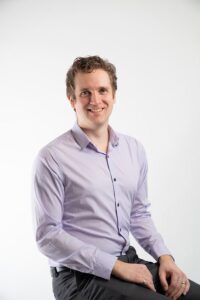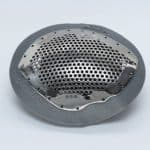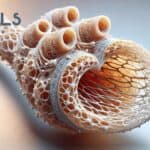Simon Beyer is the Chief Technology Officer at Aspect and oversees the advancement of our biomanufacturing technologies. He leads our engineering teams and the development of our core technologies, including bioprinting systems, microfluidic printheads, biomanufacturing automation, tissue design software, and machine learning. Simon is a principal inventor of Aspect’s microfluidic bioprinting technology with broad expertise developing advanced printing systems for applications including printed electronics, self-assembling nanomaterials, and biological tissue. Simon holds a B.A.Sc. and M.A.Sc. in Electrical Engineering from the University of British Columbia. Simon will be speaking at the upcoming 3D Printing and Microfluidics webinar: Microfluidics, Technology, Commercialization
Jenny: When was the first encounter you had with 3D printing? What was that experience like?
Simon: The first encounter I had with 3D printing was during grad school in Konrad Walus’ lab (Konrad would later become one of Aspect’s co-founders). We had one of the first consumer market 3D printers that you can get your hands on, one of the very early ones made of wood. The lab was already themed around 2D printing so 3D printing was a natural next step.
3D printing felt like a kind of freedom! It essentially eliminated the barrier to go from thinking about a design to holding something in our hands. Even early, very simple 3D printers allowed us to explore new ideas quickly, and learn quickly.
Jenny: What inspired you to start your journey in 3D printing and Bioprinting?
Simon: When Konrad first approached me to work on this project to develop a 3D bioprinting technology it sounded like pure sci-fi – I needed to be involved! I’ve always been fascinated with areas of study that bridge technical domains and I saw 3D bioprinting as this exceptional example where you have biology, chemistry, mechatronics, software, microfluidics, etc. all coming together to do something really unique. I really believe these interfaces are where breakthrough innovation happens.
The decision to start a company was one part naiveté around how difficult it would be, and two parts feeling like this would be the most effective way for our technology to become something real. 3D bioprinting was just a whisper at this point, it was a very new area, so the timing seemed right to make a real move and capture an opportunity. Knowing that what we’re doing could have a hugely positive impact on human health was a bonus at the start, and it’s what continues to drive me now.
Jenny: Who inspired you the most along this journey?
Simon: I don’t think there was any one person that I looked to for inspiration… it was really the whole founding team at Aspect (Konrad Walus, Tamer Mohamed, and Sam Wadsworth). We had, and still have, so much shared vision and passion for what we’re doing, so we really found inspiration in each other. We were also fortunate to have some very supportive early business mentors and close friends who truly cared about our success. That can make all the difference when you’re just starting a company for the first time.
Jenny: What motivates you the most for your work?
Simon: I love the technology, I love the fact that our work is hugely impactful, but hands down what motivates me the most are our team. We built a company full of incredibly smart, motivated, and kind people, and every day I get to go to work and interact with them. We talk science, we work through hard problems, and I learn from them constantly.

Jenny: What is the biggest obstacle in your line of work? If you have conquered them, what were your solutions?
Simon: There are always new problems to solve. The biggest general challenge is finding the overlap between what the biology needs in order to function, and what biomaterials are printable and appropriate for clinical use. For any new therapeutic indication, this will be a challenge but we have all the pieces to put it together at Aspect and we have been making incredible strides in the last few years.
Jenny: What do you think is the biggest challenge in 3D Printing/bio-printing? What do you think the potential solution(s) is (are)?
Simon: A few major challenges include engineering vascularization, preventing foreign body response, and sourcing scalable high-quality cells. To solve all these challenges, collaboration and partnership are key. No one can be an expert in everything so it’s important to bring the right people, skills, and expertise into the room. Aspect has an incredibly diverse team capable of tackling many components of these challenges and is collaborating with world-class researchers and companies in areas where we have gaps.
Jenny: If you are granted three wishes by a higher being, what would they be?
Simon:
- Limitless clean energy… there’s so much more we need to do to improve our relationship with the natural world, but this would help our acute existential crisis.
- More time… or just not having to sleep!
- Superluminal travel…so we can truly see how rare life is (or not!) in our universe
Jenny: What advice would you give to a smart driven college student in the “real world”? What bad advice you heard should they ignore?
Simon: In the context of starting your own business, I would tell them not to go it alone. Find co-founders with whom you share a vision and can talk to openly and honestly. I would also say to leave your ego at the door. There will be countless difficult discussions and decisions to be made, and your ego will get in the way of rationally evaluating the data and making a good decision.
Lastly, I would say to take in all advice, good or bad, and then make your own assessment and act for yourself. Even bad advice can give you useful information so don’t dismiss anything out of hand.
Related Articles:
Interview with Nick Allan: StarFish Medical
Interview with Mohsen Akbari: 3D Printing Microfluidics
Interview with Albert Folch: Beautiful Microfluidics
The Fabrication of Microfluidics, 3D Cell Culture, Organ-on-a-Chip




 Oct 02, 2021
Oct 02, 2021 







Comments